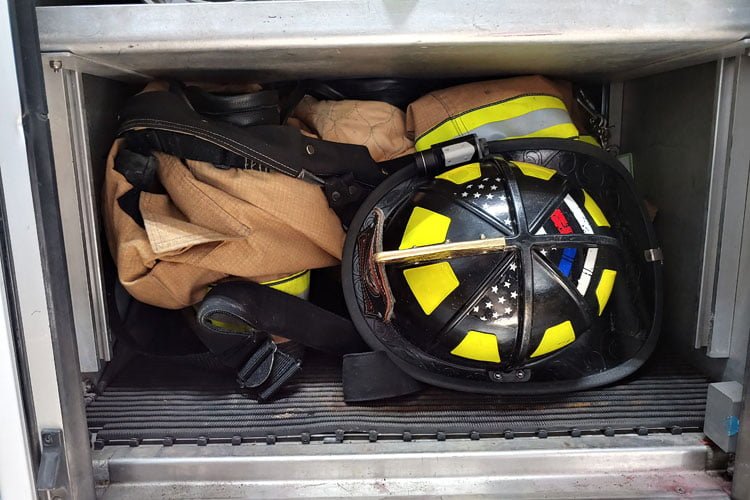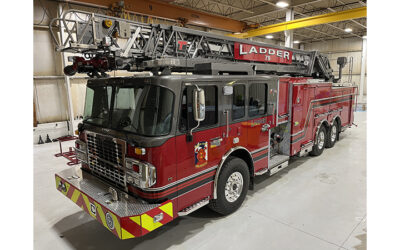By Bill Adams
In July 2019, The Rig ran “Safe Cab” Trade-Offs, which generically illustrated some possible trade-offs when adopting the concept of having an environmentally safe crew cab on fire apparatus. Possible fireground considerations and actual physical ramifications of doing so should be expounded on. To reiterate from the previous article: There is no attempt to disparage or lessen the attempt to eliminate carcinogens in a cab or negate the quest for an environmentally safe cab.
Where Is Turnout Gear Stored?
Some proponents of the concept advocate keeping turnout gear (personal protective clothing) out of the crew cab at all times. There is no questioning keeping contaminated gear out of the cab. It is immaterial if bagged and tagged contaminated gear is carried back to the station on the rig (outside the cab) or carried back in a separate vehicle.
However, if clean gear or “semi-dirty” gear (if that can even be determined and is allowed) is to be carried outside of the cab all the time including when responding to an alarm, you’ve got to find a place on the rig to store it. How much room is required to carry the turnout gear? And, is it carried in a manner that will allow fast and efficient donning after arriving on scene?
Chief Mahlon Irish of the volunteer fire department in Homer, New York, was asked to provide some dimensions of how much room is required to store a complete set of “ready-to-don” turnout gear in a compartment on one of his rigs. Interestingly, Irish, who retired as a career Lieutenant from the Ithaca (NY) Fire Department, is a cancer survivor himself and gives educational seminars to fire departments about cancer in the fire service.
Cubic Feet
He supplied a photo of a set of gear he stored on one of his pumpers. It takes up a space 27 inches wide by 15 inches high by 22 inches deep—5.16 cubic feet of space. Irish: “Actually, I would specify a taller area because of access to the gear. That area shown is very tight.” If the height of the area for the gear is increased by a couple of inches, it results in just over 6 cubic feet of space required. Doesn’t sound like much? If you have a six-person cab, you lose 36 cubic feet; an eight-person cab loses 48 cubic feet; and “staffing rich” fire departments specifying 10-person cabs will lose 60 cubic feet.
Related Content
There are a multitude of compartment configurations for every fire truck style. In an inherent desire to keep reasonable apparatus lengths and wheelbases, many departments do not specify extra compartmentation for “future expansion,” which is recommended by NFPA 1901, Standard for Automotive Fire Apparatus.
A “reasonably sized standard pumper design” (if there is such a thing!) with low side compartments has one each side ahead of the rear wheels that’s around 30 inches wide by 24 to 28 inches deep by 30 inches high. There’s usually one each side behind the rear wheels that’s about 44 inches wide by the same height and depth. (Over the wheel well and rear step compartments are not figured in.)
Which Compartment?
If there’s a four-person crew, do you store all the gear in one or two compartments? It may not be good for public relations to see four firefighters standing in line to remove their turnout gear from the fire truck while the house across the street is burning. Or, does it make sense to store one set of gear in each compartment ahead of and behind the rear wheels? All four can gear up at the same time.
More importantly, where do you store all the equipment that would normally be stored in those four compartments? Can’t do it? The alternative is to make the apparatus body longer with an accompanying longer wheelbase. Don’t want to? Find a place to store the turnout gear in exterior compartments on the cab. Not enough room? Go to a longer cab—and the longer wheelbase. Squish all the piping together in the pump house and see how much can be stored there.
Bear in mind that if more than four firefighters are going to (or may) staff the apparatus, find room for their turnout gear too. Irish added: “Don’t forget the compartment space required for six self-contained breathing apparatus if you have a six-person cab.”
Keeping contaminated turnout gear and tools out of the crew cab makes sense. Whether “uncontaminated” turnout gear is carried in the cab is a hard choice a fire department has to make. It may impact the “time to get into service” after arriving on the scene. Another consideration, possibly insignificant except to the firefighters riding the load, is getting out of the cab in a rainstorm and gearing up. It might not be as bad as it would be doing it in a snowstorm.
BILL ADAMS is a member of the Fire Apparatus & Emergency Equipment Editorial Advisory Board, a former fire apparatus salesman, and a past chief of the East Rochester (NY) Fire Department. He has 50 years of experience in the volunteer fire service.






